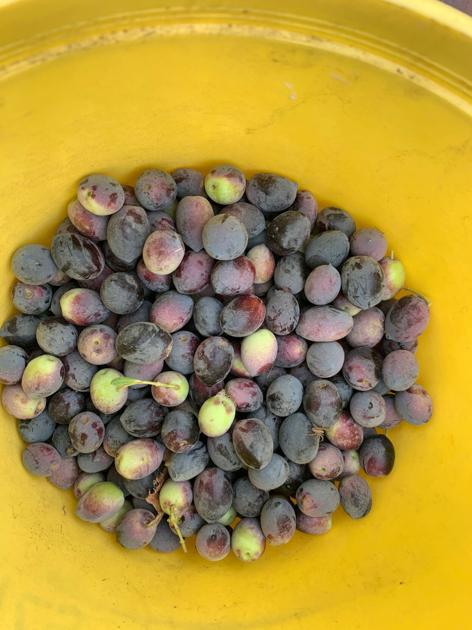
I like olives. I like eating olives, drizzling olive oil on top of a green salad and dipping toasted bread in it. I like looking at olive trees, especially the leaves — a silvery, slender, oblong-shaped delight — and olive branches, pruned and seasoned, burn hot and slow in a winter fireplace.
Recently, I was invited by a friend to cure some neighborhood olives. “Neighborhood” because scavenging is like growing your own except when you can’t grow your own, perhaps a neighbor can. Unlike theft, scavenging is ensuring something that would otherwise fall, shrivel and disappear into the soil like the magic green crystals in “James and the Giant Peach” can reach its full culinary potential.
One tree has a lot of fruit, whether it’s an orange, grapefruit, peach, plum, apricot or olive. If it’s not enough for the world, a single tree can feed six square blocks, apartments, condos and doorstep-sleepers included.
My friend Bart grows olives commercially, cures olives and makes olive oil. He’s done it all with olives. If olive trees were pigs, he’d figure out how to turn the squeal into an Italian aria.
A couple of years ago, we planted three olive trees in our backyard. This year we had a crop and I’m thinking Bart noticed and thought, “This guy might have potential.”
“Potential” or maybe everybody else was out of town. In town or out, I told him I was in.
“Bring a 5-gallon bucket,” he said.
I’ll bring a bucket and leave my attitude at home, not easy because I wear that thing like an olive-colored trench coat.
I warmed up by picking olives from one of the trees in our backyard. I was OK being the rookie in the group, the third being Chris Bergam, but I didn’t want them to think I didn’t know my way around an olive tree.
We had a lot of olives, not visible from the porch with the naked, untrained eye. Every time I picked a handful, another bunch seemed to grow in the same spot.
An hour later, I walked to 21st and Pine where we began picking olives from John Fanucchi’s tree. John is Mr. Garces, having done everything but plant the grass and stripe the lines on the tennis courts. In addition to his other good qualities, which we acknowledged but quickly forgot about, John has several olive trees and had volunteered both his trees and his services as a member of the olive-picking crew.
“Last year, we paid $7 a bucket for olives,” Bart said of his professional olive operation.
Seven dollars a bucket? I quit. So does John. You may have olives but you’ve got labor problems right here in the neighborhood.
“An experienced picker can pick five or six buckets an hour,” he said.
Maybe I was wrong. Bart didn’t have labor problems, he had laborer problems. He had a couple of olive-picking moonlighters who couldn’t pick their way into a blue, 5-gallon bucket from Lowe's.
Filling a bucket is like going on a long trip. Better not to look at the mileage signs or examine the bucket to see how many olives you’ve picked and how many you haven’t.
“Pretend like you’re milking the trees,” Bart said.
“Milking the trees.” Does that include the leaves, branches and whatever insects were swept up in the milking operation? If it didn’t, my $7 bucket was worth about two bits.
An hour later, we each had a bucket. We walked to Bart’s house to sort, clean and rinse the olives in his outside sink. Other than a garage, is there anything better than an outside sink? A man can clean fish, de-feather doves and rinse olives to his heart's content free of editorial counsel.
Cleaned, sorted and admired, the olives (Manzanillo) went back into the four, 5-gallon buckets, one of the buckets housing picholines, the small, beautiful olives grown in Gard in Southern France, in Morocco and next to the parking lot at Smart & Final on Golden State.
We soaked them in water and lye, good for making soap, unclogging drains, disinfecting floors and toilets, synthesizing drugs and curing olives. Lye penetrates to the pit and makes the bitterness more easily leached out by the water and salt baths.
We were an olive-curing machine. It was like church. Work church. A church in which the olives were as green as the ocean was blue.
My job, as the rookie, was simple: listen, don’t speak unless spoken to and be ready to step-and-fetch it.
Turned out, my bucket had a hole. The other guys didn’t shake their heads but they were probably thinking, “We asked for one thing — bring a bucket — and his leaks.”
The olives were like a baby and needed attention and changing. Three 12-hour baths of lye, three 12-hour soaks in fresh water and three in a brine made with sea salt. Then, the final soak in white wine, vinegar, oregano, garlic, salt, tarragon or whatever you want to produce an olive that, when it is refrigerated, will hold a pickle-like crispness for up to a year and a half.
Curing olives. It might be something, if not this year, maybe next. Most likely there is a tree in your neighborhood, unused, unnoticed and begging to be milked. Olives enough for this flock and thousands more.
November 08, 2020 at 03:45PM
https://ift.tt/2I82f4F
HERB BENHAM: Olives the cure for what ails you - The Bakersfield Californian
https://ift.tt/3eCf9lu
Herb
No comments:
Post a Comment